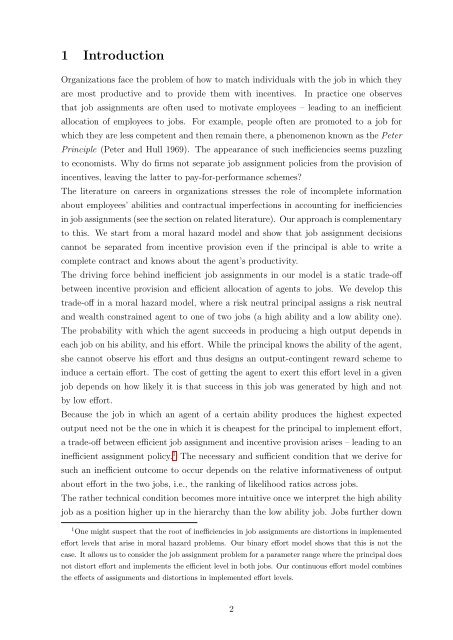Job Assignments under Moral Hazard - School of Economics and ...
Job Assignments under Moral Hazard - School of Economics and ...
Job Assignments under Moral Hazard - School of Economics and ...
You also want an ePaper? Increase the reach of your titles
YUMPU automatically turns print PDFs into web optimized ePapers that Google loves.
1 Introduction<br />
Organizations face the problem <strong>of</strong> how to match individuals with the job in which they<br />
are most productive <strong>and</strong> to provide them with incentives. In practice one observes<br />
that job assignments are <strong>of</strong>ten used to motivate employees – leading to an inefficient<br />
allocation <strong>of</strong> employees to jobs. For example, people <strong>of</strong>ten are promoted to a job for<br />
which they are less competent <strong>and</strong> then remain there, a phenomenon known as the Peter<br />
Principle (Peter <strong>and</strong> Hull 1969). The appearance <strong>of</strong> such inefficiencies seems puzzling<br />
to economists. Why do firms not separate job assignment policies from the provision <strong>of</strong><br />
incentives, leaving the latter to pay-for-performance schemes?<br />
The literature on careers in organizations stresses the role <strong>of</strong> incomplete information<br />
about employees’ abilities <strong>and</strong> contractual imperfections in accounting for inefficiencies<br />
in job assignments (see the section on related literature). Our approach is complementary<br />
to this. We start from a moral hazard model <strong>and</strong> show that job assignment decisions<br />
cannot be separated from incentive provision even if the principal is able to write a<br />
complete contract <strong>and</strong> knows about the agent’s productivity.<br />
The driving force behind inefficient job assignments in our model is a static trade-<strong>of</strong>f<br />
between incentive provision <strong>and</strong> efficient allocation <strong>of</strong> agents to jobs. We develop this<br />
trade-<strong>of</strong>f in a moral hazard model, where a risk neutral principal assigns a risk neutral<br />
<strong>and</strong> wealth constrained agent to one <strong>of</strong> two jobs (a high ability <strong>and</strong> a low ability one).<br />
The probability with which the agent succeeds in producing a high output depends in<br />
each job on his ability, <strong>and</strong> his effort. While the principal knows the ability <strong>of</strong> the agent,<br />
she cannot observe his effort <strong>and</strong> thus designs an output-contingent reward scheme to<br />
induce a certain effort. The cost <strong>of</strong> getting the agent to exert this effort level in a given<br />
job depends on how likely it is that success in this job was generated by high <strong>and</strong> not<br />
by low effort.<br />
Because the job in which an agent <strong>of</strong> a certain ability produces the highest expected<br />
output need not be the one in which it is cheapest for the principal to implement effort,<br />
a trade-<strong>of</strong>f between efficient job assignment <strong>and</strong> incentive provision arises – leading to an<br />
inefficient assignment policy. 1 The necessary <strong>and</strong> sufficient condition that we derive for<br />
such an inefficient outcome to occur depends on the relative informativeness <strong>of</strong> output<br />
about effort in the two jobs, i.e., the ranking <strong>of</strong> likelihood ratios across jobs.<br />
The rather technical condition becomes more intuitive once we interpret the high ability<br />
job as a position higher up in the hierarchy than the low ability job. <strong>Job</strong>s further down<br />
1 One might suspect that the root <strong>of</strong> inefficiencies in job assignments are distortions in implemented<br />
effort levels that arise in moral hazard problems. Our binary effort model shows that this is not the<br />
case. It allows us to consider the job assignment problem for a parameter range where the principal does<br />
not distort effort <strong>and</strong> implements the efficient level in both jobs. Our continuous effort model combines<br />
the effects <strong>of</strong> assignments <strong>and</strong> distortions in implemented effort levels.<br />
2
















